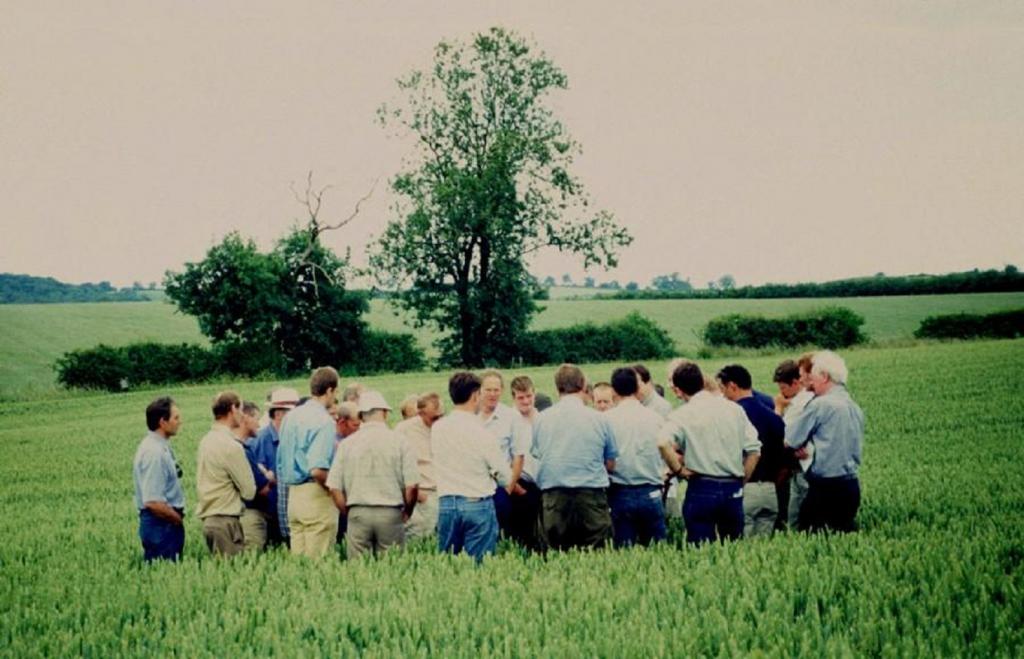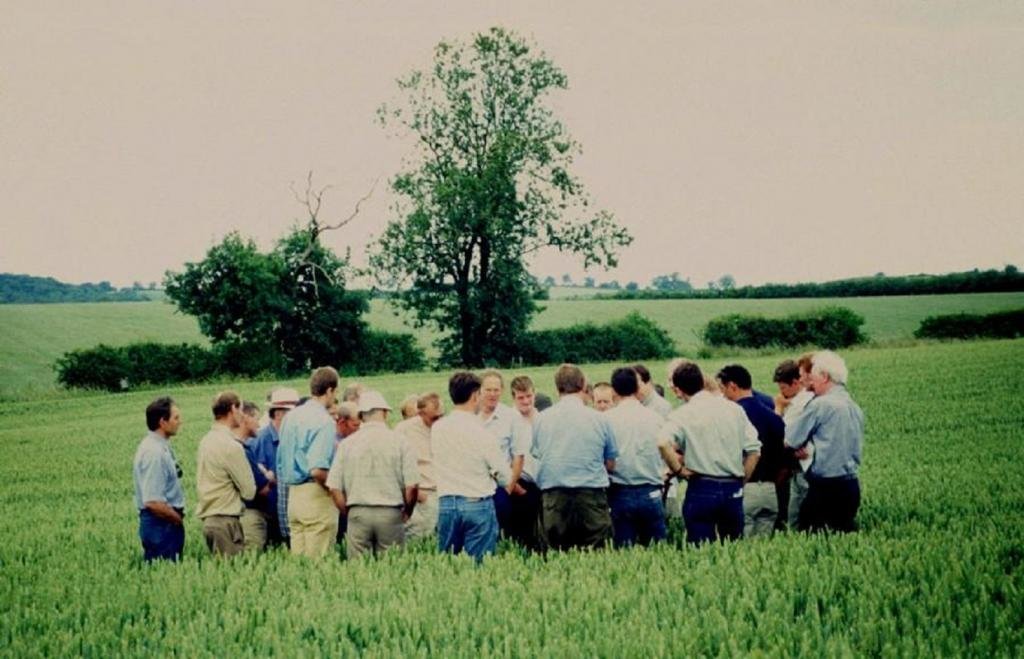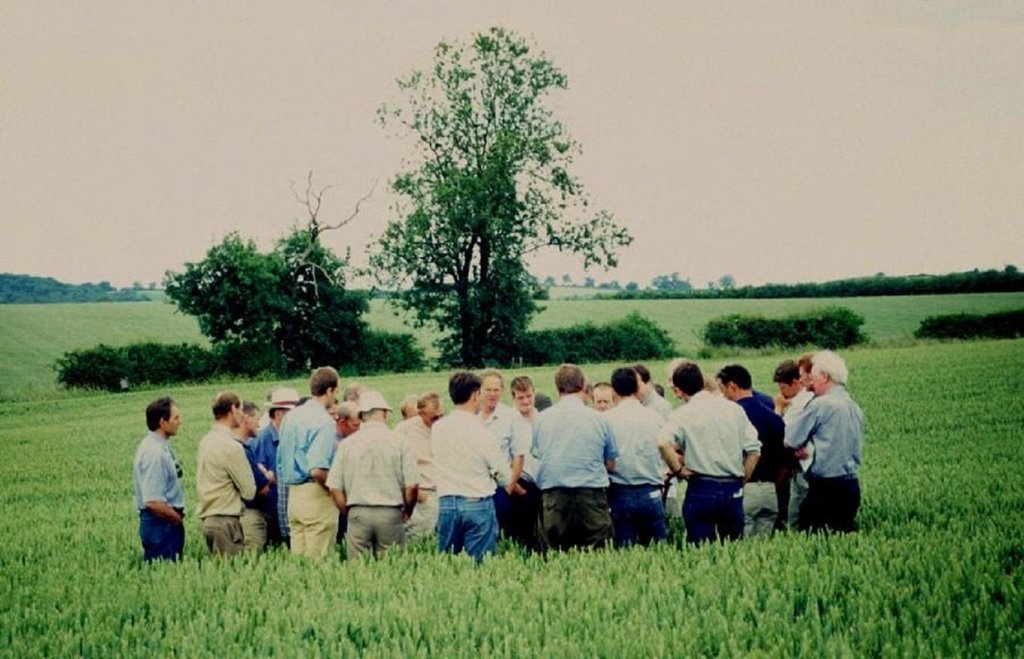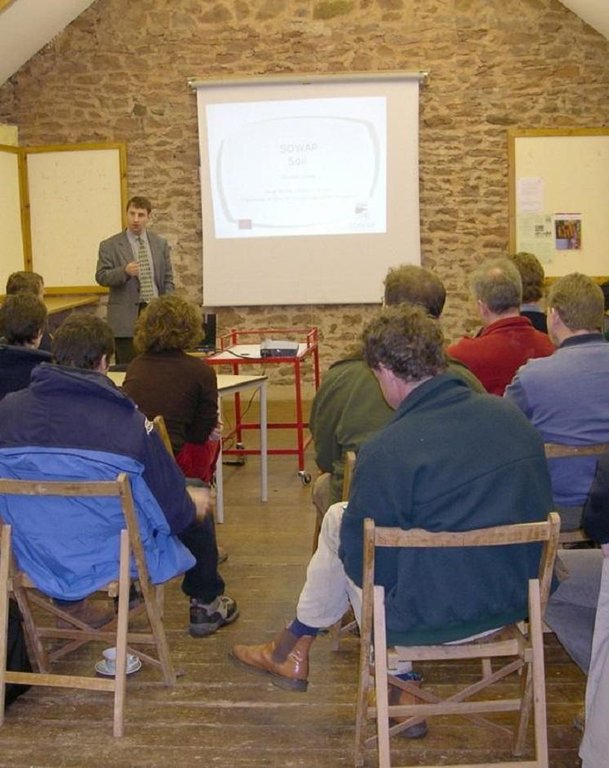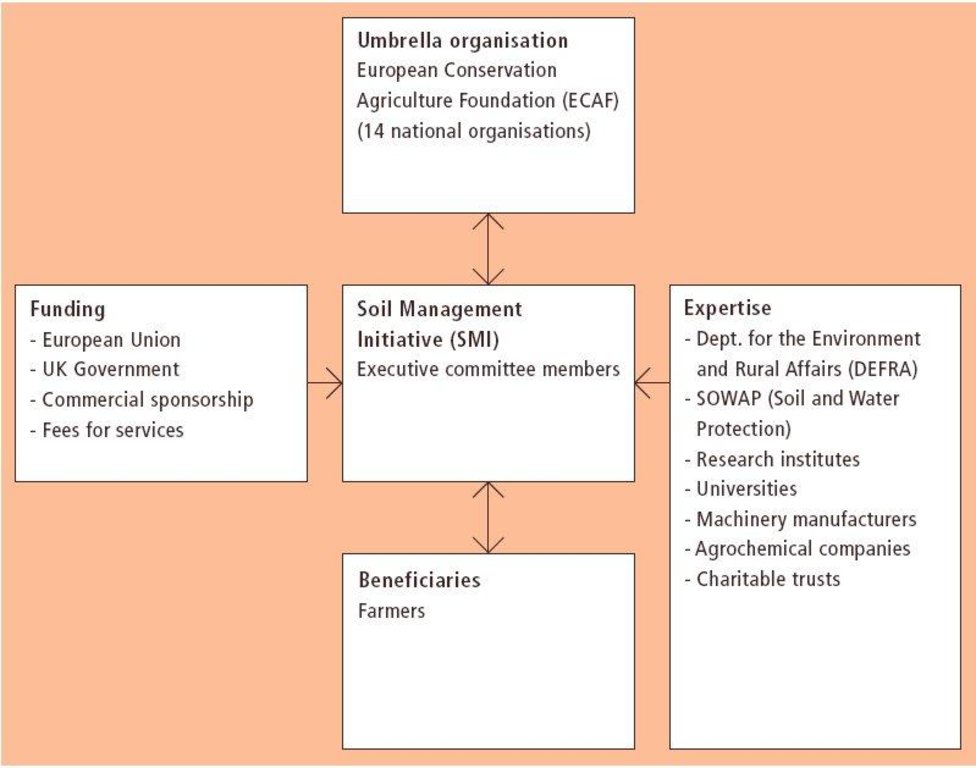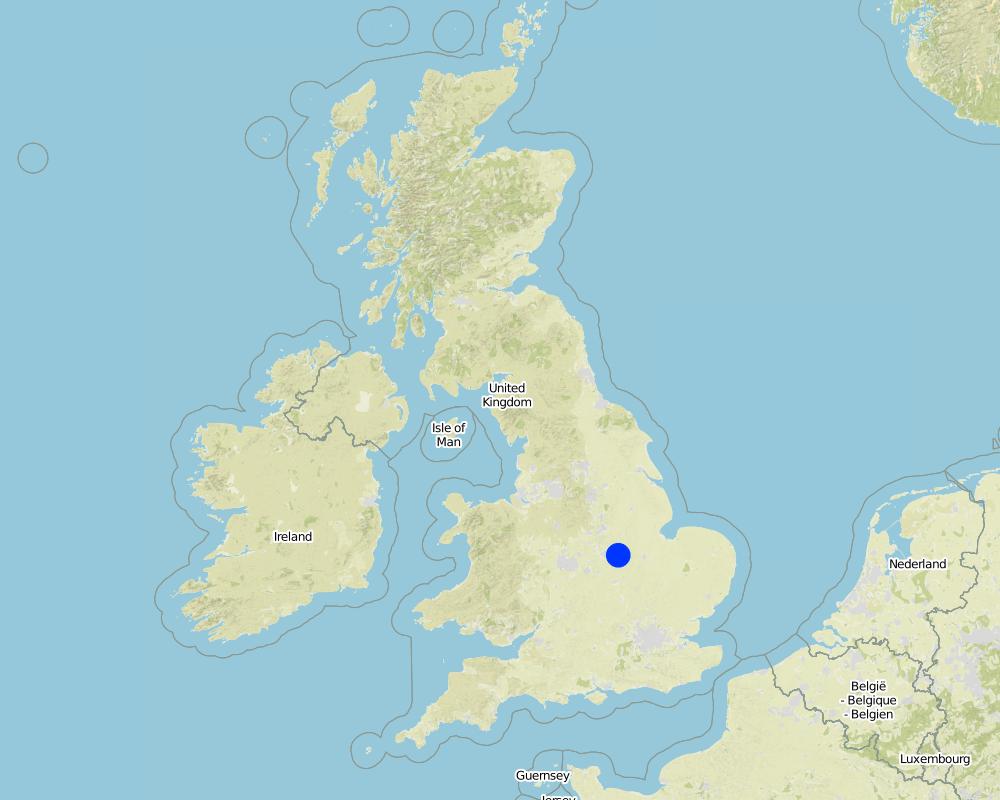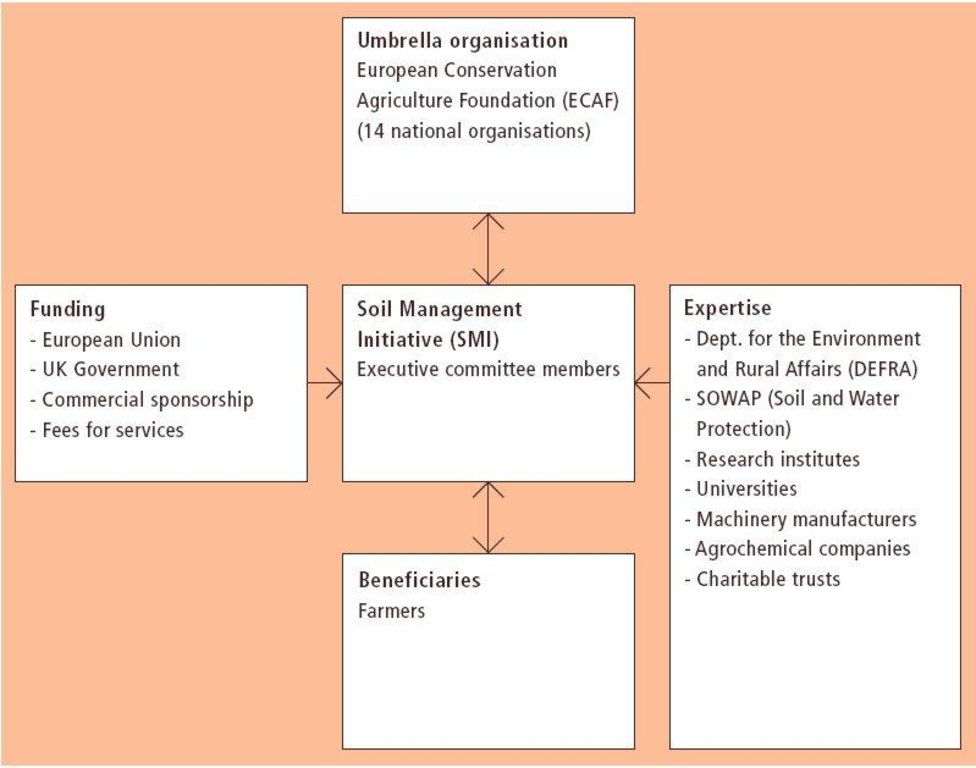Soil management initiative [United Kingdom]
- Creation:
- Update:
- Compiler: Alastaire Leake
- Editor: –
- Reviewers: Alexandra Gavilano, Fabian Ottiger, Deborah Niggli
approaches_2620 - United Kingdom
View sections
Expand all Collapse all1. General information
1.2 Contact details of resource persons and institutions involved in the assessment and documentation of the Approach
Name of project which facilitated the documentation/ evaluation of the Approach (if relevant)
Book project: where the land is greener - Case Studies and Analysis of Soil and Water Conservation Initiatives Worldwide (where the land is greener)Name of the institution(s) which facilitated the documentation/ evaluation of the Approach (if relevant)
UK Soil Management Initiative - United Kingdom1.3 Conditions regarding the use of data documented through WOCAT
The compiler and key resource person(s) accept the conditions regarding the use of data documented through WOCAT:
Ja
1.4 Reference(s) to Questionnaire(s) on SLM Technologies
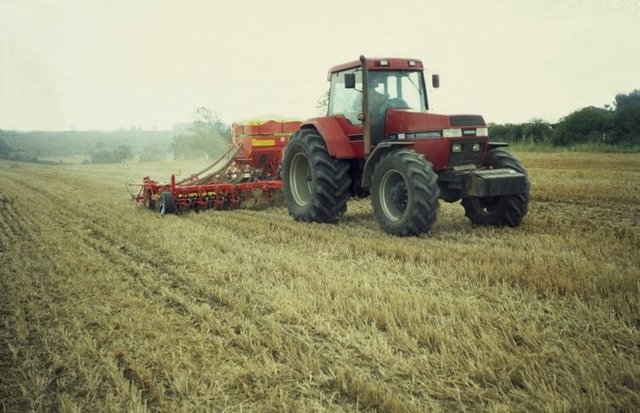
Conservation agriculture [United Kingdom]
Improved soil management based on non-inversion tillage for cost-effective and timely crop establishment.
- Compiler: Alastaire Leake
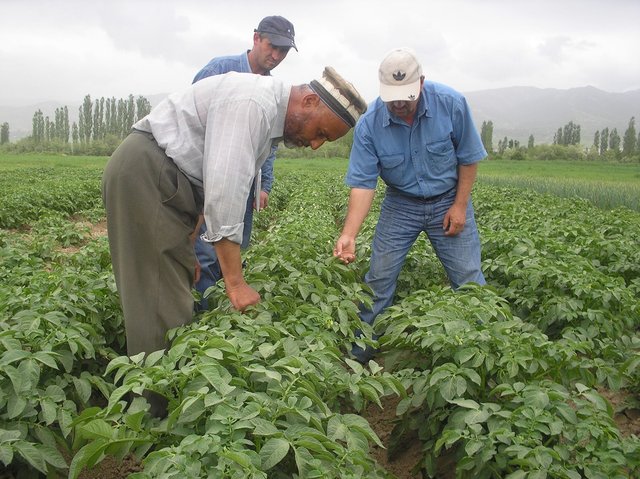
[Tajikistan]
None
- Compiler: MIZROBSHO AMIRBEKOV
2. Description of the SLM Approach
2.1 Short description of the Approach
An independent organisation that promotes the adoption of appropriate soil management practices, especially conservation agriculture, within England.
2.2 Detailed description of the Approach
Detailed description of the Approach:
Aims / objectives: The zero tillage systems promoted in the UK during the 1970s were radical. Pioneering farmers moved from ploughing to zero tillage using special direct drilling machines and non-selective contact herbicides. However, they encountered serious problems with slugs, persistent grass weeds and straw, and zero tillage was largely abandoned. Pressures to reduce crop establishment costs then led to the intermediate method of ???conservation agriculture??? (CA). The Soil Management Initiative (SMI) has been central to the development and promotion of CA. SMI is an independent non-profit organisation that was established by a small, committed group in 1999. Its aim is to promote the adoption of cultivation systems which improve soil quality, minimise soil erosion and water pollution, and simultaneously maintain or enhance farm economic returns. SMI brings together organisations with varied expertise and technical abilities, and provides both research results and advice to the large numbers of farmers who are progressively adopting CA. Furthermore, SMI was a founder member of the European Conservation Agriculture Federation (ECAF), under which there are 14 national organisations. Competence within SMI is drawn from research institutes, educational establishments, farmers and landowners, machinery manufacturers, crop protection companies, charitable trusts, and from independent agronomists and advisers.
Methods: The EU Life fund provided an initial three-year allocation to support SMI. This ended in 2002. SMI now raises finance from the UK and EU governments, commercial sponsorship (international agrochemical and machinery companies) and fees paid by farmers. In the current climate of privatisation of advisory services, there is no targeted governmental advisory body to carry out such a function. DEFRA (The UK Government???s Department for Environment, Food and Rural Affairs) does however provide some support to SMI with both funds and expertise, and is an associate member. Amongst SMI???s methods for spreading the message of improved soil management are field days - where farmers pay to attend- an interactive web-based help-line on ???lo-till??? and farmers??? magazines. SMI also undertakes extension roadshows???, visiting specific farms for question and answer sessions. A formal session with presentations from experts precedes a practical outdoor demonstration. SMI gains knowledge and practical experience from the ???joint venture??? at Loddington (see associated technology).
2.3 Photos of the Approach
2.5 Country/ region/ locations where the Approach has been applied
Country:
United Kingdom
Region/ State/ Province:
Loddington, Leicestershire
Map
×2.6 Dates of initiation and termination of the Approach
Indicate year of initiation:
1999
2.7 Type of Approach
- project/ programme based
2.8 Main aims/ objectives of the Approach
- improve technology transfer through extension to farmers
- promote agricultural and environmental policies to support sustainable soil management
- improve information exchange in and amongst the research, policy and practitioner communities and private companies (machinery and agrochemical etc)
- research, develop, evaluate and promote soil management systems to improve crop production and protection of the environment
The SLM Approach addressed the following problems:
-Attempts to apply conservation agriculture by arable farmers in the 1980s and 90s were not matched by an understanding of the whole system. There was a thirst for more knowledge.
-Privatisation of government advisory services has left a gap to be filled in this case an advisory body in sustainable soil management.
2.9 Conditions enabling or hindering implementation of the Technology/ Technologies applied under the Approach
availability/ access to financial resources and services
- hindering
SMI has needed to operate within a tight budget, and this was reduced further in 2002 when the 3-year allocation from the EU Life fund ended.
Treatment through the SLM Approach: The remedy has been to depend more on support from private companies (agrochemical and machinery) and payment by farmers for advice/attendance at field days.
legal framework (land tenure, land and water use rights)
- hindering
The existing land ownership, land use rights / water rights moderately hindered the approach implementation Ownership and the attitude of the owner towards CA can affect uptake significantly. For example, some landlords do not like tenants to practice conservation agriculture because ???it looks messy??? with trash lying on the surface rather than neatly ploughed fields.
knowledge about SLM, access to technical support
- hindering
Farmers lacked adequate knowledge regarding use of new CA implements, and emerging weed and pest control methods.
Treatment through the SLM Approach: SMI provides demand-driven technical support services.
3. Participation and roles of stakeholders involved
3.1 Stakeholders involved in the Approach and their roles
- local land users/ local communities
Differences between the participation of men and women: None in principle, though de facto most farmers are male, and they constitute the majority at field days.
- SLM specialists/ agricultural advisers
- national government (planners, decision-makers)
Govt. agencies
- contractors, environmentalists/researchers
3.2 Involvement of local land users/ local communities in the different phases of the Approach
| Involvement of local land users/ local communities | Specify who was involved and describe activities | |
|---|---|---|
| initiation/ motivation | passive | setting up SMI |
| planning | passive | setting up SMI |
| implementation | interactive | advisory services/demand-driven field events |
| monitoring/ evaluation | passive | M&E of SMI's activities |
| Research | interactive | on-farm research on conservation agriculture |
3.3 Flow chart (if available)
Description:
Institutional framework: Linkages between the Soil Management Institute, the European Conservation Agriculture Foundation, funding agencies, research institutions, land users and producers of machiner
3.4 Decision-making on the selection of SLM Technology/ Technologies
Specify who decided on the selection of the Technology/ Technologies to be implemented:
- land users alone (self-initiative)
Explain:
Decisions on the method of implementing the SLM Technology were made by by land users alone (self-initiative / bottom-up). (farmers)
4. Technical support, capacity building, and knowledge management
4.1 Capacity building/ training
Was training provided to land users/ other stakeholders?
Ja
Subjects covered:
Technical demonstrations in the field are the primary means of knowledge transfer. A formal session with presentations from experts precedes a practical outdoor demonstration. Although conservation agriculture is the umbrella topic, specific issues - such as herbicide application are treated on demand.
4.2 Advisory service
Do land users have access to an advisory service?
Ja
Specify whether advisory service is provided:
- on land users' fields
- Weekly magazine and helpopline
Describe/ comments:
Name of method used for advisory service: Roadshows; Key elements: visiting specific farms for question and answer sessions, an e-mail/website based lo-till helpline through the Farmers. Weekly magazine (www.fwi.co.uk). SMI furthermore contributes to frequent press articles as well as producing publications
4.3 Institution strengthening (organizational development)
Have institutions been established or strengthened through the Approach?
- no
4.4 Monitoring and evaluation
Is monitoring and evaluation part of the Approach?
Ja
Comments:
bio-physical aspects were regular monitored by project staff through measurements
technical aspects were regular monitored by project staff through measurements
socio-cultural aspects were ad hoc monitored by project staff through observations
economic / production aspects were regular monitored by project staff through measurements
area treated aspects were ad hoc monitored by project staff through measurements
management of Approach aspects were ad hoc monitored by project staff through observations
There were None changes in the Approach as a result of monitoring and evaluation: SMI is constantly refining its advice on the basis of results monitored from the field.
4.5 Research
Was research part of the Approach?
Ja
Specify topics:
- sociology
- economics / marketing
- ecology
Give further details and indicate who did the research:
Conservation agriculture was initially supported by public funded research. Current research - through SMI but also some research institutes and farmers themselves - is focused on specific issues, including slug control, grass weeds, trash management and soil compaction. Recently, environmental, economic and social concerns arising from the practice of conventional agriculture have been taken up
5. Financing and external material support
5.1 Annual budget for the SLM component of the Approach
Comments (e.g. main sources of funding/ major donors):
Approach costs were met by the following donors: international non-government (-): 10.0%; government (national government - DEFRA): 10.0%; international (European Union: EU Life Fund): 40.0%; local community / land user(s) (regional council): 10.0%; other (Companies: Monsanto,Syngenta): 30.0%
5.2 Financial/ material support provided to land users
Did land users receive financial/ material support for implementing the Technology/ Technologies?
Ja
If yes, specify type(s) of support, conditions, and provider(s):
There are no subsidies specifically connected to CA or sustainable soil management. However, the CA principles fall within UK new cross-compliance conditions for the Single Farm Payment scheme which effectively constitutes a subsidy to farmers for following sound land management practices. There is also a recently introduced Environmental Stewardship Scheme, which embraces environmental concerns. Under this scheme, it is likely that much of the area under conservation agriculture will qualify for, at least, the entry-level category of subsidy, currently set at approx. US$ 60/ha/year: note: this is on top of the single farm payment, which will be considerably greater (for more details see www.defra.gov.uk). Manufacturers of non-inversion tillage equipment provide machines for demonstration. Manufacturers of biocides provided finance and support to specific farmers in the early stages of progressive development.
5.3 Subsidies for specific inputs (including labour)
- agricultural
| Specify which inputs were subsidised | To which extent | Specify subsidies |
|---|---|---|
| Biocides | partly financed | |
If labour by land users was a substantial input, was it:
- voluntary
Comments:
Farmers themselves provide labour though the adoption of conservation agriculture involves a considerable saving
5.4 Credit
Was credit provided under the Approach for SLM activities?
Nee
6. Impact analysis and concluding statements
6.1 Impacts of the Approach
Did the Approach help land users to implement and maintain SLM Technologies?
- No
- Yes, little
- Yes, moderately
- Yes, greatly
erosion reduced, organic matter built up, nitrate losses reduced etc
Did other land users / projects adopt the Approach?
- No
- Yes, little
- Yes, moderately
- Yes, greatly
There are other similar service providers in different aspects of farming, though not in soil management.
6.3 Sustainability of Approach activities
Can the land users sustain what has been implemented through the Approach (without external support)?
- yes
If yes, describe how:
SMI can continue to support land users with advice as long as they are prepared to continue paying for the services, and sponsorship continues from agencies and commercial companies. Land users can continue to practice CA without external support - but services such as those provided by SMI are extremely valuable.
6.4 Strengths/ advantages of the Approach
| Strengths/ advantages/ opportunities in the compiler’s or other key resource person’s view |
|---|
| Has successfully stimulated conservation agriculture, which should in turn ultimately lead to environmentally sound and sustainable land management in England (How to sustain/ enhance this strength: Continue operations for as long as possible) |
| SMI has acted effectively as a channel for making results from research, and a wide body of experience, readily available to farmers (How to sustain/ enhance this strength: Continue to focus on farmers as the main target group and link them with research and private companies.) |
| SMI has managed to combine the efforts and expertise of a wide range of actors towards a common goal: to provide a unique advisory service in conservation agriculture (How to sustain/ enhance this strength: Continue to serve as a centre of excellence.) |
| Improvements in soil management techniques have been documented in an accessible way (How to sustain/ enhance this strength: Continue to publish simply and clearly as new messages develop.) |
| Ad hoc advice available via a web-based helpline (How to sustain/ enhance this strength: Continue.) |
6.5 Weaknesses/ disadvantages of the Approach and ways of overcoming them
| Weaknesses/ disadvantages/ risks in the compiler’s or other key resource person’s view | How can they be overcome? |
|---|---|
| SMI has an on-going problem with adequacy of funding | Through top-class services, continue to attract funds and voluntary contributions from a wide range of actors. |
7. References and links
7.1 Methods/ sources of information
- field visits, field surveys
- interviews with land users
7.2 References to available publications
Title, author, year, ISBN:
Soil Management Initiative/Department for Environment, Food and Rural Affairs (DEFRA) (undated) A guide to managing cropManagement Initiative (undated) Improved soil management for agronomic and environmentalSoil Management Initiative/V??derstad (undated) Target on establishment: innovation for the future of farming.
Available from where? Costs?
(www.smi.org.uk)SMI, UKSMI, UK
Title, author, year, ISBN:
Management Initiative (undated) Improved soil management for agronomic and environmental
Available from where? Costs?
SMI, UK
Title, author, year, ISBN:
Soil Management Initiative/V??derstad (undated) Target on establishment: innovation for the future of farming.
Available from where? Costs?
SMI, UK
Links and modules
Expand all Collapse allLinks

Conservation agriculture [United Kingdom]
Improved soil management based on non-inversion tillage for cost-effective and timely crop establishment.
- Compiler: Alastaire Leake

[Tajikistan]
None
- Compiler: MIZROBSHO AMIRBEKOV
Modules
No modules


